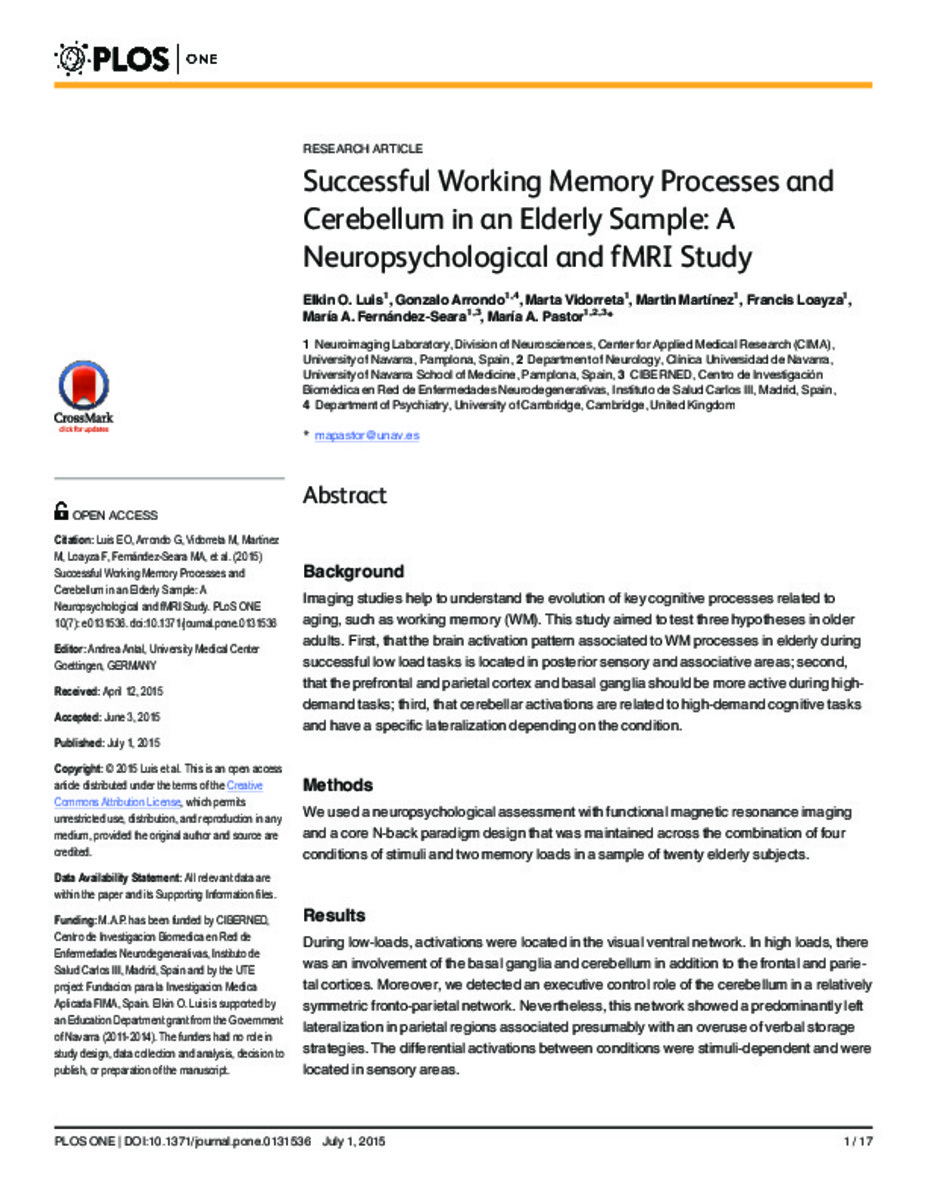Full metadata record
| DC Field | Value | Language |
|---|---|---|
| dc.creator | Luis-Garcia, E.O. (Elkin Oswaldo) | - |
| dc.creator | Arrondo, G. (Gonzalo) | - |
| dc.creator | Vidorreta, M. (Marta) | - |
| dc.creator | Martinez, M. (Martín) | - |
| dc.creator | Loayza, F.R. (Francis R.) | - |
| dc.creator | Fernández-Seara, M.A. (María A.) | - |
| dc.creator | Pastor, M.A. (María A.) | - |
| dc.date.accessioned | 2017-06-07T11:03:48Z | - |
| dc.date.available | 2017-06-07T11:03:48Z | - |
| dc.date.issued | 2015 | - |
| dc.identifier.citation | Luis, E.O.; Arrondo, G.; Vidorreta, M.; et al. "Successful working memory processes and cerebellum in an elderly sample: A neuropsychological and fMRI study". Plos one. 10 (7), 2015, e0131536 | es_ES |
| dc.identifier.issn | 1932-6203 | - |
| dc.identifier.uri | https://hdl.handle.net/10171/43574 | - |
| dc.description.abstract | Background Imaging studies help to understand the evolution of key cognitive processes related to aging, such as working memory (WM). This study aimed to test three hypotheses in older adults. First, that the brain activation pattern associated to WM processes in elderly during successful low load tasks is located in posterior sensory and associative areas; second, that the prefrontal and parietal cortex and basal ganglia should be more active during high-demand tasks; third, that cerebellar activations are related to high-demand cognitive tasks and have a specific lateralization depending on the condition. Methods We used a neuropsychological assessment with functional magnetic resonance imaging and a core N-back paradigm design that was maintained across the combination of four conditions of stimuli and two memory loads in a sample of twenty elderly subjects. Results During low-loads, activations were located in the visual ventral network. In high loads, there was an involvement of the basal ganglia and cerebellum in addition to the frontal and parietal cortices. Moreover, we detected an executive control role of the cerebellum in a relatively symmetric fronto-parietal network. Nevertheless, this network showed a predominantly left lateralization in parietal regions associated presumably with an overuse of verbal storage strategies. The differential activations between conditions were stimuli-dependent and were located in sensory areas. Conclusion Successful WM processes in the elderly population are accompanied by an activation pattern that involves cerebellar regions working together with a fronto-parietal network. | es_ES |
| dc.language.iso | eng | es_ES |
| dc.publisher | Public Library of Science | es_ES |
| dc.rights | info:eu-repo/semantics/openAccess | es_ES |
| dc.subject | Brain activation | es_ES |
| dc.subject | Older adults | es_ES |
| dc.subject | Cerebellar activations | es_ES |
| dc.subject | Memory processes | es_ES |
| dc.subject | Materias Investigacion::Ciencias de la Salud::Neurología | es_ES |
| dc.title | Successful working memory processes and cerebellum in an elderly sample: A neuropsychological and fMRI study | es_ES |
| dc.type | info:eu-repo/semantics/article | es_ES |
| dc.description.note | This is an open access article distributed under the terms of the Creative Commons Attribution License, which permits unrestricted use, distribution, and reproduction in any medium, provided the original author and source are credited. | es_ES |
| dc.identifier.doi | https://doi.org/10.1371/journal.pone.0131536 | es_ES |
| dadun.citation.number | 7 | es_ES |
| dadun.citation.publicationName | Plos one | es_ES |
| dadun.citation.startingPage | e0131536 | es_ES |
| dadun.citation.volume | 10 | es_ES |
Files in This Item:
Statistics and impact
Items in Dadun are protected by copyright, with all rights reserved, unless otherwise indicated.






